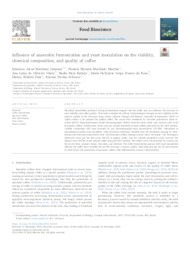Influence of anaerobic fermentation and yeast inoculation on the viability, chemical composition, and quality of coffee.
Influence of anaerobic fermentation and yeast inoculation on the viability, chemical composition, and quality of coffee.
Author(s): JIMENEZ, E. J. M.; MARTINS, P. M. M.; VILELA, A. L. de O.; BATISTA, N. N.; ROSA, S. D. V. F. da; DIAS, D. R.; SCHWAN, R. F.
Summary: Microbial metabolites produced during fermentation migrate into the coffee and can influence the decrease in seed viability and coffee quality. This study evaluated the effects of physiological changes in seed viability on the sensory quality of the beverage using starter cultures through self-induced anaerobic fermentation (SIAF) in Coffea arabica L. for natural and pulped coffee. The yeasts were monitored by real-time polymerase chain reaction (qPCR). High-performance liquid chromatography (HPLC) detected citric, malic, and succinic acids in all fermented coffees. Furthermore, lactic acid was mainly identified in those coffees processed by the SIAF method. Volatile compounds (40) were detected by gas chromatography-mass spectrometry (GC-MS). Alterations in physiological quality were identified, with decreased embryonic viability and cell membrane damage by tetrazolium and electrical conductivity tests. All fermented coffees obtained scores above 80 points. The Torulospora delbrueckii yeast got the best score (86.50) in pulped coffee, and the Candida parapsilosis yeast received the highest score (85.90) in the natural coffee using the SIAF method. The coffees were characterized by aromas and flavors of citrus, caramel, honey, chocolate, and chestnut. The coffee fermentation process with yeast inoculation affected the coffee bean viability but not the beverage's sensory quality, indicating that the use of yeast starters by SIAF favors the production of specialty coffees with differentiated sensory characteristics.
Publication year: 2023
Types of publication: Journal article
Unit: Embrapa Coffee
Keywords: Anaerobic conditions, Coffea Arábica, Fermentation, Seed quality
Observation
Some of Embrapa's publications are published as ePub files. To read them, use or download one of the following free software options to your computer or mobile device. Android: Google Play Books; IOS: iBooks; Windows and Linux: Calibre.
Access other publications
Access the Agricultural Research Database (BDPA) to consult Embrapa's full library collection and records.
Visit Embrapa Bookstore to purchase books and other publications sold by Embrapa.

